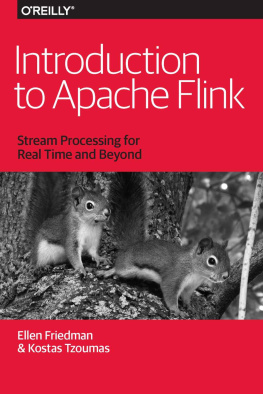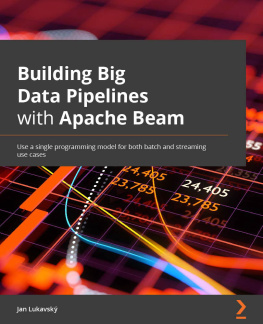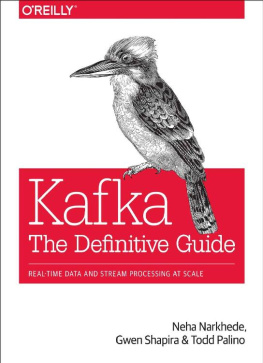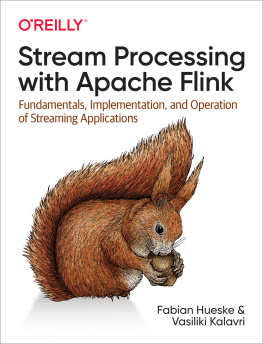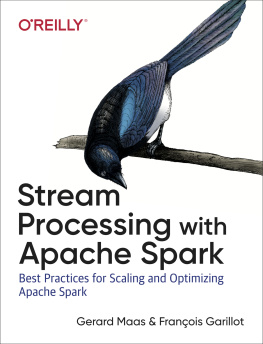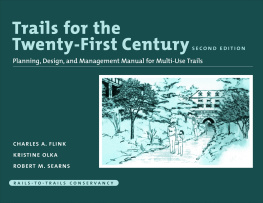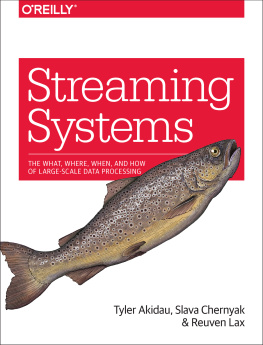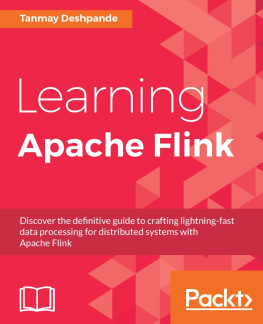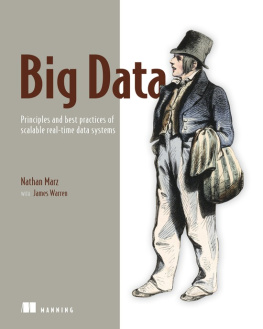Friedman Ellen - Introduction to Apache Flink
Here you can read online Friedman Ellen - Introduction to Apache Flink full text of the book (entire story) in english for free. Download pdf and epub, get meaning, cover and reviews about this ebook. year: 2016, publisher: O’Reilly Media, genre: Computer. Description of the work, (preface) as well as reviews are available. Best literature library LitArk.com created for fans of good reading and offers a wide selection of genres:
Romance novel
Science fiction
Adventure
Detective
Science
History
Home and family
Prose
Art
Politics
Computer
Non-fiction
Religion
Business
Children
Humor
Choose a favorite category and find really read worthwhile books. Enjoy immersion in the world of imagination, feel the emotions of the characters or learn something new for yourself, make an fascinating discovery.
- Book:Introduction to Apache Flink
- Author:
- Publisher:O’Reilly Media
- Genre:
- Year:2016
- Rating:5 / 5
- Favourites:Add to favourites
- Your mark:
- 100
- 1
- 2
- 3
- 4
- 5
Introduction to Apache Flink: summary, description and annotation
We offer to read an annotation, description, summary or preface (depends on what the author of the book "Introduction to Apache Flink" wrote himself). If you haven't found the necessary information about the book — write in the comments, we will try to find it.
Introduction to Apache Flink — read online for free the complete book (whole text) full work
Below is the text of the book, divided by pages. System saving the place of the last page read, allows you to conveniently read the book "Introduction to Apache Flink" online for free, without having to search again every time where you left off. Put a bookmark, and you can go to the page where you finished reading at any time.
Font size:
Interval:
Bookmark:
Stream Processing for Real Time and Beyond
Ellen Friedman and Kostas Tzoumas
by Ellen Friedman and Kostas Tzoumas
Copyright 2016 Ellen Friedman and Kostas Tzoumas. All rights reserved.
All images copyright Ellen Friedman unless otherwise noted. Figure 1-3 courtesy Michael Vasilyev / Alamy Stock Photo.
Printed in the United States of America.
Published by OReilly Media, Inc. , 1005 Gravenstein Highway North, Sebastopol, CA 95472.
OReilly books may be purchased for educational, business, or sales promotional use. Online editions are also available for most titles (http://safaribooksonline.com). For more information, contact our corporate/institutional sales department: 800-998-9938 or corporate@oreilly.com .
- Editor: Shannon Cutt
- Production Editor: Holly Bauer Forsyth
- Copyeditor: Holly Bauer Forsyth
- Proofreader: Octal Publishing, Inc.
- Interior Designer: David Futato
- Cover Designer: Karen Montgomery
- Illustrator: Rebecca Panzer
- September 2016: First Edition
- 2016-09-01: First Release
- 2016-10-20: Second Release
The OReilly logo is a registered trademark of OReilly Media, Inc. Introduction to Apache Flink, the cover image, and related trade dress are trademarks of OReilly Media, Inc.
While the publisher and the authors have used good faith efforts to ensure that the information and instructions contained in this work are accurate, the publisher and the authors disclaim all responsibility for errors or omissions, including without limitation responsibility for damages resulting from the use of or reliance on this work. Use of the information and instructions contained in this work is at your own risk. If any code samples or other technology this work contains or describes is subject to open source licenses or the intellectual property rights of others, it is your responsibility to ensure that your use thereof complies with such licenses and/or rights.
978-1-491-97658-6
[LSI]
Theres a flood of interest in learning how to analyze streaming data in large-scale systems, partly because there are situations in which the time-value of data makes real-time analytics so attractive. But gathering in-the-moment insights made possible by very low-latency applications is just one of the benefits of high-performance stream processing.
In this book, we offer an introduction to Apache Flink, a highly innovative open source stream processor with a surprising range of capabilities that help you take advantage of stream-based approaches. Flink not only enables fault-tolerant, truly real-time analytics, it can also analyze historical data and greatly simplify your data pipeline. Perhaps most surprising is that Flink lets you do streaming analytics as well as batch jobs, both with one technology. Flinks expressivity and robust performance make it easy to develop applications, and Flinks architecture makes those easy to maintain in production.
Not only do we explain what Flink can do, we also describe how people are using it, including in production. Flink has an active and rapidly growing open international community of developers and users. The first Flink-only conference, called Flink Forward, was held in Berlin in October 2015, the second is scheduled for September 2016, and there are Apache Flink meetups around the world, with new use cases being widely reported.
This book will be useful for both nontechnical and technical readers. No specialized skills or previous experience with stream processing are necessary to understand the explanations of underlying concepts of Flinks designs and capabilities, although a general familiarity with big data systems is helpful. To be able to use sample code or the tutorials referenced in the book, experience with Java or Scala is needed, but the key concepts underlying these examples are explained clearly in this book even without needing to understand the code itself.
Chapters provide a deeper, technical explanation of Flinks capabilities.
This icon indicates a general note.
This icon signifies a tip or suggestion.
This icon indicates a warning or caution.
Many of the systems we need to understand cars in motion emitting GPS signals, financial transactions, interchange of signals between cell phone towers and people busy with their smartphones, web traffic, machine logs, measurements from industrial sensors and wearable devices all proceed as a continuous flow of events. If you have the ability to efficiently analyze streaming data at large scale, youre in a much better position to understand these systems and to do so in a timely manner. In short, streaming data is a better fit for the way we live.
Its natural, therefore, to want to collect data as a stream of events and to process data as a stream, but up until now, that has not been the standard approach. Streaming isnt entirely new, but it has been considered as a specialized and often challenging approach. Instead, enterprise data infrastructure has usually assumed that data is organized as finite sets with beginnings and ends that at some point become complete. Its been done this way largely because this assumption makes it easier to build systems that store and process data, but it is in many ways a forced fit to the way life happens.
So there is an appeal to processing data as streams, but thats been difficult to do well, and the challenges of doing so are even greater now as people have begun to work with data at very large scale across a wide variety of sectors. Its a matter of physics that with large-scale distributed systems, exact consistency and certain knowledge of the order of events are necessarily limited. But as our methods and technologies evolve, we can strive to make these limitations innocuous in so far as they affect our business and operational goals.
Thats where Apache Flink comes in. Built as open source software by an open community, Flink provides stream processing for large-volume data, and it also lets you handle batch analytics, with one technology.
Its been engineered to overcome certain tradeoffs that have limited the effectiveness or ease-of-use of other approaches to processing streaming data.
In this book, well investigate potential advantages of working well with data streams so that you can see if a stream-based approach is a good fit for your particular business goals. Some of the sources of streaming data and some of the situations that make this approach useful may surprise you. In addition, the will book help you understand Flinks technology and how it tackles the challenges of stream processing.
In this chapter, we explore what people want to achieve by analyzing streaming data and some of the challenges of doing so at large scale. We also introduce you to Flink and take a first look at how people are using it, including in production.
Who needs to work with streaming data? Some of the first examples that come to mind are people working with sensor measurements or financial transactions, and those are certainly situations where stream processing is useful. But there are much more widespread sources of streaming data: clickstream data that reflects user behavior on websites and machine logs for your own data center are two familiar examples. In fact, streaming data sources are essentially ubiquitous its just that there has generally been a disconnect between data from continuous events and the consumption of that data in batch-style computation. Thats now changing with the development of new technologies to handle large-scale streaming data.
Font size:
Interval:
Bookmark:
Similar books «Introduction to Apache Flink»
Look at similar books to Introduction to Apache Flink. We have selected literature similar in name and meaning in the hope of providing readers with more options to find new, interesting, not yet read works.
Discussion, reviews of the book Introduction to Apache Flink and just readers' own opinions. Leave your comments, write what you think about the work, its meaning or the main characters. Specify what exactly you liked and what you didn't like, and why you think so.

